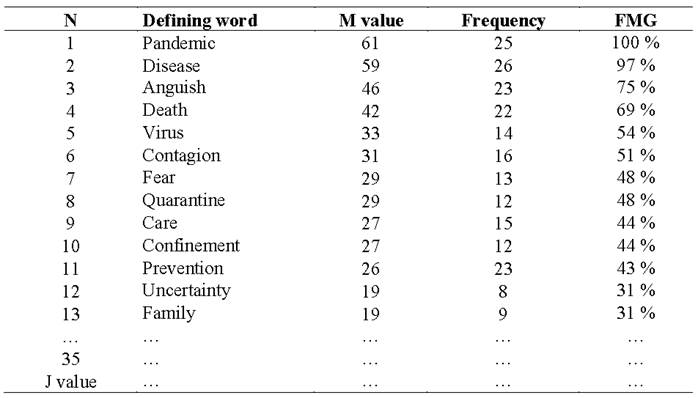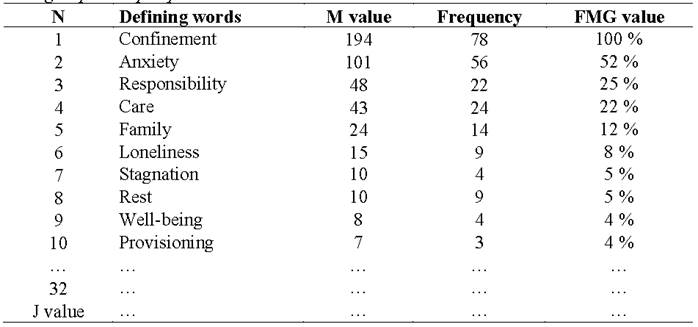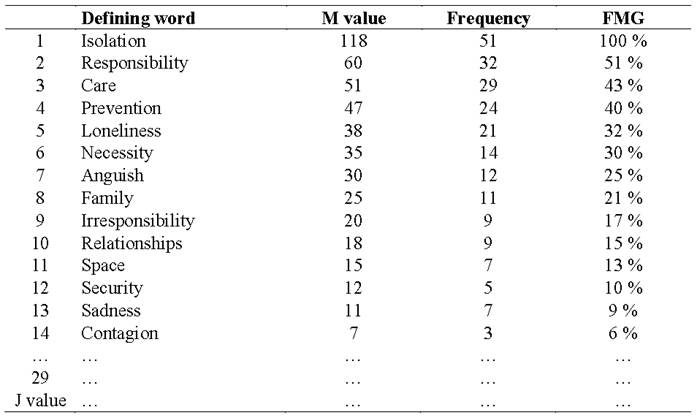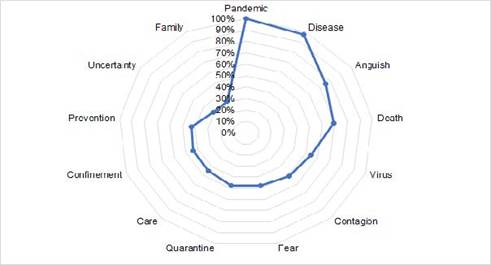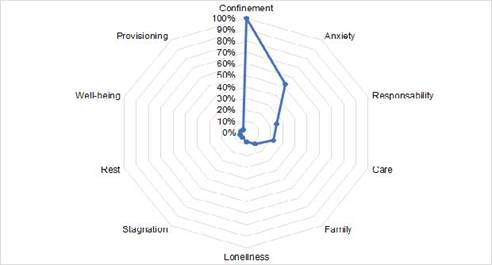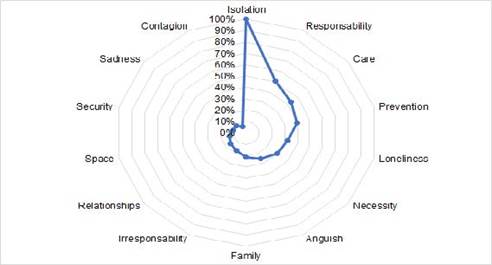Services on Demand
Journal
Article
Related links
Share
Ciencias Psicológicas
Print version ISSN 1688-4094On-line version ISSN 1688-4221
Cienc. Psicol. vol.15 no.2 Montevideo Dec. 2021 Epub Dec 01, 2021
https://doi.org/10.22235/cp.v15i2.2280
Original Articles
Social representations about the COVID-19 pandemic of Chilean higher education students
1 Universidad de Las Américas, Chile
2 Universidad de Las Américas, Chile, jvergaram@udla.cl
3 Universidad de Las Américas, Chile
The COVID-19 has caused multiple effects on the physical and mental health of the world’s population. From the psychosocial perspective, this study proposes to understand the social representations about the COVID-19 pandemic of Chilean higher education students. The participants were a total of 92 Chilean higher education students. Data collection was carried out using a questionnaire of social representations, which included the following stimulus words: (a) COVID-19, (b) quarantine, and (c) social distancing. The data were analyzed using natural semantic network analysis. The results showed that the thematic categories of the COVID-19 are mainly related to biological, emotional and value aspects. For quarantine and social distancing, thematic categories are related to emotional and value aspects. The results are discussed based on the understanding of the categories of thought that promote behavior in the context of a health emergency.
Keywords: COVID-19; pandemic; social representations; structural model; health psychology
La COVID-19 ha provocado múltiples efectos en la salud física y mental de la población mundial. Desde la perspectiva psicosocial, este estudio propone comprender las representaciones sociales sobre la pandemia de la COVID-19 en estudiantes chilenos de educación superior. Los participantes fueron un total de 92 estudiantes. La recolección de los datos se realizó mediante un cuestionario de representaciones sociales, que incluyó las siguientes palabras estímulos: (a) COVID-19, (b) cuarentena, y (c) distanciamiento social. Los datos fueron analizados mediante análisis de redes semánticas naturales. Los resultados muestran que las categorías temáticas sobre la COVID-19 se relacionan principalmente con aspectos biológicos, emocionales y valorativos. Para la cuarentena y el distanciamiento social, las categorías temáticas se relacionan con aspectos emocionales y valorativos. Se discuten los resultados en función de la comprensión de las categorías de pensamiento que promueven el comportamiento en contexto de emergencia sanitaria.
Palabras clave: COVID-19; pandemia; representaciones sociales; modelo estructural; psicología de la salud
O COVID-19 provocou múltiplos efeitos na saúde física e mental da população mundial. A partir de uma perspectiva psicossocial, este estudo se propõe a compreender as representações sociais sobre a pandemia do COVID-19 de estudantes chilenos do ensino superior. Os participantes foram um total de 92 estudantes. A coleta de dados foi realizada por meio de um questionário de representações sociais, que incluiu as seguintes palavras estímulo: (a) COVID-19, (b) quarentena, e (c) distanciamento social. Os dados foram analisados por meio de análise de rede semântica natural. Os resultados mostram que as categorias temáticas sobre o COVID-19 estão relacionadas principalmente com aspectos biológicos, emocionais e apreciativos. Para quarentena e distanciamento social, as categorias temáticas estão relacionadas a aspectos emocionais e apreciativos. Os resultados são discutidos a partir da compreensão das categorias de pensamento que promovem o comportamento no contexto de uma emergência sanitária.
Palavras-chave: COVID-19; pandemia; representações sociais; modelo estrutural; psicologia da saúde
The current pandemic of COVID-19 has had multiple effects on the physical and mental health of the world's population. To contain its spread, most governments have promoted actions aimed at limiting people's mobility to avoid spaces of physical contact, which has affected the development of economic activities (Conejo, Chaverri-Chaves & León-González, 2020). However, the experience of confinement has had different consequences on the mental health of the population, mainly related to anxiety and stress disorders (Conejo et al., 2020). In this regard, the World Health Organization (WHO) highlights the importance of including social science disciplines to broaden understanding as to why people have certain prevention and response practices for some diseases and not for others, despite the information that is disseminated regarding the benefits or dangers of their behavior (Torres-López, Núñez-Sandoval & De la Cruz-Villarreal, 2017).
From the review of the antecedents, studies on COVID-19 focused on attitudes, beliefs and knowledge are identified, from which the effect on the mental health of the population is highlighted, related to the rupture of everyday meaning that has implied high degrees of uncertainty, fear, and anguish in people (Johnson, Saletti-Cuesta & Tumas, 2020). While a marked presence of emotional aspects such as hypersensitivity and sadness are identified (Pérez, 2020), evaluative aspects such as a sense of responsibility and care management are also highlighted, also involving the intersubjective relationships that emerge in the context of pandemics (Johnson et al., 2020).
When considering the current pandemic context, the study of social representations is of great relevance for future interventions in health emergencies, as well as for understanding the thought structures that guide behavior in health emergency contexts. Social representations are understood as thought structures that enable the interpretation of an event or object and guide the meaning of behavior (Páez & Pérez, 2020). For this reason, the perspective of social representations constitutes the theoretical underpinning of the study, as it allows us to investigate the understanding of the world from a practical perspective, where diverse, socially shared knowledge, understandings and explanations converge, giving meaning to the behavior of the population in the context of the COVID-19 pandemic.
During the pandemic context, marked difficulties related to cognitions and emotions that affect people’s behavior have been observed (Urzúa, Vera-Villarroel, Caqueo-Urízar & Polanco-Carrasco, 2020). For this reason, it is considered important to conduct a study focused on understanding the structures of thought since the pandemic is a phenomenon in the process that needs to be analyzed from the multiple dimensions of its consequences, to have scientific knowledge that contributes to the development and strengthening of preventive behaviors for health emergencies.
Social representations
Social representations refer to the socially and historically constructed knowledge in which meaning about things, people and their actions is configured. In this sense, it allows social scientists to approach the multiple categories that are created around different social aspects such as health, illness, and care (Carrasquilla, González, Camargo, Soto & Ramos, 2019). They are understood as symbolic constructions that originate in social interaction and are recreated over time (Marková, 2017). Social representations can be understood as a specific type of knowledge that expresses how everyday life operates (Jodelet, 1986). To understand how the representations that are configured around the COVID-19 pandemic operate, and to conceptualize the processes by which opinions, attitudes, stereotypes, and behaviors are created, it is necessary to analyze the thematic categories that are socially communicated in the current context (Rubira-García & Puebla-Martínez, 2018).
Social representations are configured through a set of information, beliefs, opinions, and attitudes associated with a specific object or situation, which are structured as an organized whole. Furthermore, they are social because they are configured through a collective process, facilitating the understanding of everyday reality (Caniuqueo et al., 2018). From the perspective of the structural model, it is proposed that social representations are based on the transformation of the abstract into concrete experiences (Rateau & Lo Monaco, 2013). While it is recognized that social representations operate as a partnership, elements have identified that function independently and complementarily at the same time, referred to as the central core and peripheral elements. The central core is understood as the inner face of the representations and is made up of several cognitive elements, also called central, which would perform various functions of vital importance for what will be the purpose and usefulness of the representations. On the one hand, it gives meaning, so that from the core, the other elements take on value and a specific significance for the individuals in the group. It also fulfils the task of organizing those aspects that depend on the central core. The peripheral elements are closely related to the practical purposes of SRs; they function as the operational guide that the subjects will have (Rateau & Lo Monaco, 2013).
In crisis scenarios, social representations constitute socio-cognitive processes that make it possible to order and understand reality. Because they are constituted at the group level, they allow for a simplified image of the phenomenon to be represented. Each representation responds to the urgency situationally, to the need to be linked to what is happening here and now. They emerge as a way of controlling what is alien, with an overload of data, images, beliefs, and many contradictions. Social representations operate through multimodal media, words, symbols, icons, images. They give meaning to the current pandemic situation, configured from the daily repetition that facilitates the perception of something concrete and close. They arise from the social world, that is, from a totality constituted by cultural, economic, political processes, etc., being a way of relating to the world. Categories not only allow the configuration of images but also facilitate the way we relate to others (Vergara, 2008). In this case, they influence the development of our daily life: the forms of work, family relationships, the sense of duty, leisure time, sexual activity, sporting activity, etc. To recognize and describe them, it is necessary to denaturalize social life, to take a distance and to try to recognize phenomena in which we are also involved as objective processes (Höijer, 2011).
Health psychology and pandemic
Health psychology is a discipline that can respond to pandemic situations, as its objectives include health promotion and maintenance, as well as prevention and treatment of disease through the modification of habits. From this discipline, the construction of scientific knowledge has allowed the development of explanatory models that incorporate an interdisciplinary perspective, considering the cultural and health context in which the disease occurs. In this way, it has assumed an important role in the planning of preventive health actions, highlighting that these have to consider the social values and meanings of the social group affected (Torres-López et al., 2017).
Concerning the pandemic phenomenon, the WHO (n.d.) considers it to be a global expansion of a new disease, in a scenario where the majority of the population lacks immunity. SARS-CoV-2 is a new virus that spread worldwide, causing the COVID-19 pandemic, from which new knowledge and multiple studies have gradually emerged and are under development. From the empirical background review, pandemic studies are observed in the context of the health emergency associated with H1N1 influenza. A study conducted from the social representations approach showed that influenza A beliefs, for the most part, revolved around ways of contagion and preventive actions. In addition, plot theories were identified, understood as rumors that emerge when there are events that produce an experience of social tension. It refers to unconfirmed speculative information, which conditions the behavior of individuals (Guzmán, Guzmán & Guzmán, 2011). Another study conducted with Mexican students and teachers showed that social representations about H1N1 influenza that favor prevention practices are based on the perception of symptoms, transmission mechanisms and suggested care attention. In addition, it was identified that social representations that may hinder preventive practices are associated with a perception of disbelief towards authorities and uncertainty about the information that is transmitted (Torres-López, Matsui & Aranda, 2012).
On the other hand, a study focused on analyzing the social representations of human influenza in Mexican adolescents, considering the period during the 2009 epidemic and the 2016 outbreak. The results showed that social representations about influenza in 2009 corresponded to a thought structure in the process of construction, with contradictory aspects regarding its origin, since both a perception of danger and a perception of deception about the pandemic are described. For the case of 2016, it is possible to infer a resignification of social representations, as they focused on issues associated with symptoms and consequences (Torres-López et al., 2017). A study on knowledge, attitudes, and practices about H1N1 influenza, according to urban and rural populations in China, showed that knowledge about the disease was unclear. In addition, positive attitudes and practices for prevention were only reported by highly educated women, which is associated with a high perceived risk of infection (Lin et al., 2011).
Based on the background information reviewed, the study aims to understand the social representations of the COVID-19 pandemic among Chilean higher education students.
Method
Design research
The research was carried out using qualitative methodology, as it was oriented towards the analysis of the subjective perspective and how reality is perceived. From this perspective, a meaningful understanding of the phenomena is sought (Rodríguez, Gil & García, 1999).
Participants
The participants were a total of 92 higher education students from 15 Chilean educational institutions. Seventy-five percent were female (n = 69) and 25 % were male (n = 23). The age of the participants ranged from 19 to 65 years, with a mean age of 28.3 years (SD = 8.4). Concerning the study programmes, 51 % of the participants had a degree in social sciences, 36 % in biological and veterinary sciences, 11 % in engineering and 2 % in architecture, construction and design. Regarding the educational process, participants were in their fifth (38 %), fourth (24 %), third (14 %), second (15 %) and first-year (9 %). Participants were selected by non-probabilistic incidental sampling. Inclusion criteria were: (a) being a regular student, and (b) studying between 1st and 5th year of the study programme.
Instrument
Social Representations Questionnaire: was applied to investigate social representations about the COVID-19 pandemic. Three stimulus words were used: a) Covid-19, b) quarantine, and c) social distancing. Responses were guided by the instruction to write down 3 words related to the stimulus words. The words were then listed in order of importance from 1 to 3. In this regard, the number 3 was considered as the highest rank for the defining word and the number 1 was considered as the lowest rank.
Data analysis
The social representations were analyzed using natural semantic network analysis, as it allows for the investigation of the shared meanings about a specific object (Hinojosa, 2008). The analysis involved the calculation of the following indicators: (a) M-value understood as an indicator of the semantic weight of each defining word, which is calculated by multiplying the frequency of occurrence with the defined hierarchy; (b) SAM set, understood as the central core of the semantic network, which is made up of the 10 or 15 defining words that obtain the highest M-value; and (c) FMG value, understood as the semantic distance between the different defining words, which is calculated by a rule of three that considers the defining word with the highest M value, which represents 100 % (Castañeda, 2016).
Procedures
The data collection process was carried out in an online format, using the Google Forms application. The study considered the ethical principles established for research with human beings (Acevedo, 2002). Data collection implied voluntary acceptance of participation in the research, in addition to the confidentiality of the information. The ethical criteria of the American Psychological Association (APA) were considered.
Results
Descriptive analysis
Table 1 shows that the COVID-19 defining words with the highest semantic weight are: pandemic (M = 61), disease (M = 59), anguish (M = 46), death (M = 42), virus (M = 33) and contagion (M = 31). These words constitute the most important group of the central core of the semantic network on COVID-19. On the other hand, the defining words with the lowest semantic weight are: family (M = 19), uncertainty (M = 19) and prevention (M = 26).
Table 2 shows that the quarantine defining words with the highest semantic weight are: confinement (M = 194), anxiety (M = 101), responsibility (M = 48) and care (M = 43). These words constitute the most important group of the central core of the quarantine semantic network. On the other hand, the defining words with the lowest semantic weight are: provisioning (M = 7), well-being (M = 8), rest (M = 10) and stagnation (M = 10).
Table 3 shows that the defining words on social distancing with the highest semantic weight are: isolation (M = 118), responsibility (M = 60), care (M = 51) and prevention (M = 47). These words constitute the most important group of the central core of the semantic network on social distancing. On the other hand, the defining words with the lowest semantic weight are: contagion (M = 7), sadness (M = 11), security (M = 12) and space (M = 15).
Semantic network analysis
Figure 1 shows that the defining words about COVID-19 are structured through thematic categories mainly related to biological, emotional and evaluative aspects. Concerning the core of the representation, it is mainly constituted through the perception of aspects involved in COVID-19 infection (pandemic, disease, anguish, death, virus, contagion), which also includes emotional reactions such as anguish and fear. On the other hand, the peripheral elements are structured based on thematic categories with emotional implications related to uncertainty, and value implications associated with care, confinement, prevention, and family.
Figure 2 shows that the defining words about quarantine are structured through thematic categories mainly related to emotional and value aspects. About the core of the representation, it is mainly constituted through elements with emotional implications such as confinement and anxiety, also including elements with value implications such as responsibility, care and family. On the other hand, the peripheral elements are structured based on thematic categories with emotional implications such as loneliness and stagnation, as well as emotional implications related to rest, well-being and provisioning.
Figure 3 shows that the defining words about social distancing are structured through thematic categories related to emotional and evaluative aspects. Regarding the core of the representation, it is mainly constituted through elements with emotional implications such as isolation, loneliness, and anguish. They also include value aspects such as responsibility, care, prevention, necessity and family. On the other hand, the peripheral elements are structured based on thematic categories with emotional implications such as sadness, irresponsibility, and contagion, as well as aspects with evaluative implications such as relationships, space, and security.
Discussion and conclusions
The research aims to understand the social representations of Chilean higher education students about the COVID-19 pandemic. From the findings, it is observed that the social representations about COVID-19 are divided into biological, emotional, and evaluative thematic categories. The predominance of biological aspects in the core of the representation is inferred, also including emotional aspects such as anguish and fear. The peripheral elements are associated with aspects with emotional implications such as uncertainty, as well as evaluative aspects such as care and family. In this way, it is inferred that students structure a health thinking about COVID-19 since a perception centered on the category of illness predominates. These findings are consistent with the results of research conducted in the context of the H1N1 influenza pandemic, as the participants' beliefs were based on ways of contagion and preventive actions (Guzmán et al., 2011).
However, thoughts about COVID-19 also include relevant emotional reactions, which is consistent with the findings of Johnson et al. (2020), Roy et al. (2020) and Torres-López et al. (2012), as they infer an effect on mental health manifested in expressions of distress, fear, worry and uncertainty. In this regard, it is suggested that these expressions constitute negative responses that may be more detrimental to the mental health of the population. However, these findings differ from the results of Pérez's study (2020), from which a low frequency of stress and fear responses was reported, which was associated with the perception of confidence in the way in which public institutions control the pandemic. Therefore, to the extent that the population perceives adequate management of the pandemic, a lower tendency towards the development of negative responses that are detrimental to mental health can be observed.
About the semantic networks of the stimulus words quarantine and social distancing, coincidences are observed in the thematic categories, which are related to emotional and evaluative aspects. In this respect, it can be inferred that the students structure a way of thinking that values the preventive aspects of quarantine, highlighting the responsibility in the care they must assume during the pandemic stage, considering the consequences that can affect both personal and family well-being. These findings differ from the results of the works of Guzmán et al. (2011) and Torres-López et al. (2012), where obstacles were observed in the structuring of preventive practices, caused by unconfirmed speculative information, perceived disbelief in the authorities and uncertainty about the information that is transmitted. Therefore, the management of information about the pandemic is a fundamental function in shaping the meaning of preventive behaviors.
On the other hand, emotional reactions such as anguish, anxiety, loneliness, and sadness are also observed, which may be linked to the feeling of confinement experienced in the face of control measures. In this regard, the results of the work of Johnson et al. (2020) show that these emotional reactions are expressed when there is a perception of reduced comfort at home in the context of health measures such as quarantine and social distancing. Therefore, while there is perception consistent with the meaning of the health measures that need to be implemented, the perception of the material characteristics in which these measures are taken can negatively affect mental health.
From the findings, it is concluded that the students' thought structures about the current pandemic situation involve a valuational and emotional experience that influences mental health. In this regard, it is observed that social representations, understood as a socio-cognitive process, constitute symbolic constructions that facilitate the configuration of the meaning of preventive strategies based on responsibility and care. However, aspects related to the emergence of emotions that can increase the negative effects on mental health if they are not intervened on time are identified. In addition, it is inferred that the perception of the conditions of the homes where confinement is experienced and how the pandemic is controlled at the institutional level also have an impact on people's emotional state. From the perspective of health psychology, it is possible to propose, as a response to pandemic situations, the promotion of interventions focused on support networks that promote emotional regulation actions, to facilitate adaptation and cope in pandemic contexts. It is also important to incorporate technological supports that facilitate the management of information on pandemic control. This will make it possible to support people's mental health by planning preventive actions.
Currently, analyzing social representations of the COVID-19 pandemic makes it possible to recognize the structures of thought about the current pandemic situation, observing the expression of reactions and evaluations that could influence people's behavior and mental health. This research constitutes a contribution to future research on pandemics or similar situations, as it provides evidence on the category system that influences the behavior of Chilean higher education students. One limitation is that the data were collected using only the free association technique. Future research must include other types of instruments to complement the observed data. Another limitation is that the sample focused on students in higher education. For future research, it is relevant to consider a more heterogeneous sample, which will provide knowledge for the construction of community-oriented strategies.
REFERENCES
Acevedo, I. (2002). Aspectos éticos en la investigación científica. Ciencia y Enfermería, 8(1), 15-18. doi: https://doi.org//10.4067/S0717-95532002000100003 [ Links ]
Caniuqueo, A., Hernández-Mosqueira, C., Troyano, A., Riquelme, D., Vargas, A., Vargas, R. & Fernandes, J. (2018). Representaciones sociales: el significado de la educación física para los estudiantes de esa disciplina. Revista Electrónica de Investigación Educativa, 20(1), 104-111. doi: https://doi.org/10.24320/redie.2018.20.1.1497 [ Links ]
Carrasquilla, D., González, G., Camargo, D., Soto, N., & Ramos, E. (2019). Representaciones sociales de salud, enfermedad y cuidado cultural en músicos tradicionales. Revista Cubana De Enfermería, 35(1). [ Links ]
Castañeda, A. (2016). Las redes semánticas naturales como estrategia metodológica para conocer las representaciones sociales acerca de la investigación en el contexto de la formación profesional de los comunicadores. Estudios sobre las Culturas Contemporáneas, XXII(43), 123-168. [ Links ]
Conejo, L., Chaverri-Chaves, P., & León-González, S. (2020). Las familias y la pandemia del COVID-19. Revista Electrónica Educare, 24(Suplemento), 37-40. doi: http://dx.doi.org/10.15359/ree.24-s.10 [ Links ]
Guzmán, M. O., Guzmán, M. A. O., & Guzmán, M. G. O. (2011). Representación infantil de la influenza A, a través de un dibujo a tema. Psicología para América Latina, (22), 1-13. [ Links ]
Hinojosa, G. (2008). El tratamiento estadístico de las redes semánticas naturales. Revista Internacional de Ciencias Sociales y Humanidades, SOCIOTAM, XVIII(1), 133-154. [ Links ]
Höijer, B. (2011). Social Representations Theory. Nordicom Review, 32(2), 3-16. doi: https://doi.org/10.1515/nor-2017-0109 [ Links ]
Jodelet, D. (1986). La representación social: fenómenos, concepto y teoría. En S. Moscovici (Ed.), Psicología social II. Pensamiento y vida social (pp. 469-493). Barcelona, España: Editorial Paidós. [ Links ]
Johnson, M. C., Saletti-Cuesta, L., & Tumas, N. (2020). Emociones, preocupaciones y reflexiones frente a la pandemia del COVID-19 en Argentina. Ciência & Saúde Coletiva, 25(Suppl. 1), 2447-2456. doi: https://doi.org/10.1590/1413-81232020256.1.10472020 [ Links ]
Lin, Y., Huang, L., Nie, S., Liu, Z., Yu, H., Yan, W., & Xu, Y. (2011). Knowledge, Attitudes and Practices (KAP) related to the Pandemic (H1N1) 2009 among Chinese General Population: a Telephone Survey. BMC Infect Dis 11, 128. doi: https://doi.org/10.1186/1471-2334-11-128 [ Links ]
Marková, I. (2017). The making of the theory of social representations. Cuadernos de Pesquisa, 47(163), 358-375. doi: https://doi.org/10.1590/198053143760 [ Links ]
Organización Mundial de la Salud (OMS) (s.f.). Alerta y Respuesta Mundiales (GAR). Recuperado de https://www.who.int/csr/disease/swineflu/frequently_asked_questions/pandemic/es/ [ Links ]
Páez, D. & Pérez, J. (2020). Social representations of COVID-19. International Journal of Social Psychology, 35(3), 600-610. doi: https://doi.org/10.1080/02134748.2020.1783852 [ Links ]
Pérez, C. (2020). Actitudes frecuentes en una población de Alamar ante la COVID 19 en tiempo real. Revista Habanera de Ciencias Médicas, 19(5), e3411. [ Links ]
Rateau, P., & Lo Monaco, G. (2013). La Teoría de las Representaciones Sociales: Orientaciones conceptuales, campos de aplicaciones y método. CES Psicología, 6(1), 22-42. [ Links ]
Rodríguez, G., Gil, J., & García, E. (1999). Metodología de la investigación cualitativa. España: Ediciones Aljibe. [ Links ]
Roy, D., Tripathy, S., Kar, S. K., Sharma, N., Verma, S. K., & Kaushal, V. (2020). Study of knowledge, attitude, anxiety & perceived mental healthcare need in Indian population during COVID-19 pandemic. Asian journal of psychiatry, 51, 102083. doi: https://doi.org/10.1016/j.ajp.2020.102083 [ Links ]
Rubira-García, R., & Puebla-Martínez, B. (2018). Representaciones sociales y comunicación: apuntes teóricos para un diálogo interdisciplinar inconcluso. Convergencia, 25(76), 147-167. doi: https://doi.org/10.29101/crcs.v25i76.4590 [ Links ]
Torres-López, T. M., Matsui, O. J., & Aranda, C. (2012). Dimensiones culturales del concepto de influenza humana en estudiantes y docentes de ciencias de la salud que favorecen o dificultan su prevención. Desacatos, (39), 45-56. [ Links ]
Torres-López, T. M., Núñez-Sandoval, Y. C., & De la Cruz-Villarreal, A. (2017). Representaciones sociales de la influenza humana de adolescentes de la ciudad de Guadalajara, México. Actualidades en Psicología, 31(122), 17-30. doi: https://doi.org/10.15517/ap.v31i122.24578 [ Links ]
Urzúa, A., Vera-Villarroel, P., Caqueo-Urízar, A., & Polanco-Carrasco, R. (2020). La Psicología en la prevención y manejo del COVID-19. Aportes desde la evidencia inicial. Terapia psicológica, 38(1), 103-118. doi: https://doi.org/10.4067/S0718-48082020000100103 [ Links ]
Vergara, M. C. (2008). La naturaleza de las representaciones sociales. Revista Latinoamericana de Ciencias Sociales, Niñez y Juventud, 6(1), 55-80. [ Links ]
Correspondence: Jorge Vergara-Morales, Universidad de Las Américas, Chile. E-mail: jvergaram@udla.cl
How to cite: Salas-Durán, K., Vergara-Morales, J., Ogueda, J. P. (2021). Social representations about the COVID-19 pandemic of Chilean higher education students. Ciencias Psicológicas, 15(2), e-2280. doi: https://doi.org/10.22235/cp.v15i2.2280
Authors' participation: a) Conception and design of the work; b) Data acquisition; c) Analysis and interpretation of data; d) Writing of the manuscript; e) Critical review of the manuscript. K. S-D. has contributed in a, b, c, d; J. V-M. in a, c, d, e; and J. P. O. in a, e.
Received: September 17, 2020; Accepted: May 19, 2021











 text in
text in 


